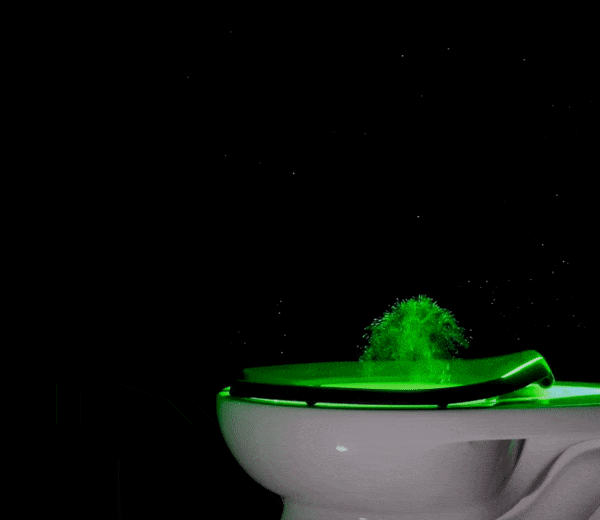Microbes, Bacteria, Viruses
'Superbugs' Could Kill Up to Ten Million Additional People Each Year by 2050
A new U.N. report warns that climate change, pollution and biodiversity loss are helping create pathogens that can evade our medications
Here's What Really Happens When You Flush a Toilet
Using lasers and cameras, scientists visualized the plume of tiny, aerosolized particles ejected from commercial toilets during flushing
Scientists Revive 48,500-Year-Old Virus, Setting World Record
As temperatures rise because of climate change, melting permafrost could cause dormant diseases to re-emerge, researchers warn
The Science Behind Your Cheese
The food is not just a tasty snack—it’s an ecosystem
Gut Bacteria Might Shape Social Behavior
A study of zebrafish reveals the mix of microbes in the intestinal tract could influence brain development
‘Conan the Bacterium’ Has What It Takes to Survive on Mars
After experiments here on Earth, researchers say some hardy microbes could endure hundreds of millions of years on the Red Planet
Scientists Are Finding Fungi in Cancerous Tumors
Experts aren't sure if the fungi affect the disease's progression
Could UV Light Reduce the Spread of Covid-19 in Indoor Spaces?
Some wavelengths of light in a range called far-UVC kill microbes in experiments and appear to be harmless to people
California Has Legalized Human Composting
By 2027, Golden State residents will have the choice to turn their bodies into nutrient-rich compost
Human Pathogens Are Hitching a Ride on Floating Plastic
Studies show that various harmful bacteria cling to microplastics in seawater
Universal Flu Vaccine Enters Clinical Trials in Humans
The test will inoculate 100 volunteers with a vaccine that protected mice from lethal doses of six different flu strains
World’s Largest Bacterium Discovered in Caribbean Mangrove Swamps
The bacterium is the size of an eyelash and visible to the naked eye
What You Need to Know About the History of Monkeypox
Mired in misconception, the poxvirus is endemic in certain African countries but was rarely reported in Europe and the U.S. until recently
Some Allergies Associated With Lower Risk of SARS-CoV-2 Infection
An NIH study found that food allergies reduced risk of infection by 50 percent
Untold Stories of American History
The Woman Who Fought to End the 'Pernicious' Scourge of Kissing
New understandings of how disease spread informed Imogene Rechtin's ill-fated 1910 campaign to ban a universal human practice
Scientists Map Yellowstone’s Underground ‘Plumbing’
The new survey could be useful for everything from microbiology to thermal energy
Bald Eagles Are Dying From Bird Flu
The highly contagious H5N1 strain is also infecting commercial chickens and turkeys
Virologists Identify More Than 5,000 New Viruses in the Ocean
The new study focused on under-researched RNA viruses, which often infect animals and humans
Even Mild Covid-19 Infections May Change the Brain, New Study Finds
Scans taken before and after a case of coronavirus reveal tissue damage and accelerated loss of gray matter
First Possible Case of Covid-19 Spreading From Deer to Humans
Experts say the discovery is not reason for panic, but underscores the importance of monitoring wildlife for diseases that could infect humans
:focal(4096x2731:4097x2732)/https://tf-cmsv2-smithsonianmag-media.s3.amazonaws.com/filer_public/1d/c5/1dc53b53-c1cf-4106-8b54-11b4f4279ef6/pexels-edward-jenner-4031442.jpg)

:focal(1500x1043:1501x1044)/https://tf-cmsv2-smithsonianmag-media.s3.amazonaws.com/filer_public/a8/a7/a8a7b60a-b2e2-49b0-9a9d-ab5f8f336da5/gettyimages-154958999.jpg)
:focal(800x602:801x603)/https://tf-cmsv2-smithsonianmag-media.s3.amazonaws.com/filer_public/6c/c6/6cc6c4ed-54ab-4b1c-88c5-dcf45a2c1f1f/gettyimages-1041943928_web.jpg)
:focal(2656x1694:2657x1695)/https://tf-cmsv2-smithsonianmag-media.s3.amazonaws.com/filer_public/65/f7/65f779d7-bcb1-446b-bb66-f8b31606584c/gettyimages-1172306258.jpg)
:focal(1000x567:1001x568)/https://tf-cmsv2-smithsonianmag-media.s3.amazonaws.com/filer_public/6c/79/6c796b9c-a529-419c-910c-b90c973ad4a6/pia24311-_01_approach_2000.jpeg)
:focal(2750x1833:2751x1834)/https://tf-cmsv2-smithsonianmag-media.s3.amazonaws.com/filer_public/61/d4/61d4c2bd-ad1e-49d3-b345-fb0c03be1111/gettyimages-509396612.jpg)
:focal(3024x2016:3025x2017)/https://tf-cmsv2-smithsonianmag-media.s3.amazonaws.com/filer_public/85/83/8583e5dc-58a9-4545-92fc-53f8c3f0ad49/gettyimages-1207642410.jpg)
:focal(960x722:961x723)/https://tf-cmsv2-smithsonianmag-media.s3.amazonaws.com/filer_public/3c/fe/3cfe2340-e940-40df-89c6-b08cd14be7d7/fresh-2386786_1920.jpg)
:focal(800x602:801x603)/https://tf-cmsv2-smithsonianmag-media.s3.amazonaws.com/filer_public/c8/80/c88095ce-9378-4613-a7fc-dd3d9bcfab88/gettyimages-1230667049_web.jpg)
:focal(579x435:580x436)/https://tf-cmsv2-smithsonianmag-media.s3.amazonaws.com/filer_public/dc/70/dc70f9c5-e5a7-4205-9280-dcb6f0e9eb87/20220628-flu-vaccine.jpg)
:focal(350x280:351x281)/https://tf-cmsv2-smithsonianmag-media.s3.amazonaws.com/filer_public/f1/96/f1963b3c-a9b3-4f1d-b163-8a4977199d64/low-res_thiomargarita_single_filament_jean-marie_volland.jpeg)
:focal(1024x790:1025x791)/https://tf-cmsv2-smithsonianmag-media.s3.amazonaws.com/filer_public/ea/1a/ea1a3aa3-62ff-4389-a6a6-fc0c179562b3/52096775365_47a17637ba_k.jpg)
:focal(768x600:769x601)/https://tf-cmsv2-smithsonianmag-media.s3.amazonaws.com/filer_public/06/af/06af14b4-711c-49d8-b6e2-5f19066dcbd5/novel_coronavirus_sars-cov-2.jpg)
:focal(700x527:701x528)/https://tf-cmsv2-smithsonianmag-media.s3.amazonaws.com/filer_public/14/83/1483ad30-7fb5-404c-bfc3-809c17177265/my_first_kiss2.jpg)
:focal(1024x683:1025x684)/https://tf-cmsv2-smithsonianmag-media.s3.amazonaws.com/filer_public/92/fa/92fabd99-3656-493a-992b-a34abfeca36d/24810228331_42d9937f33_k.jpg)
:focal(960x640:961x641)/https://tf-cmsv2-smithsonianmag-media.s3.amazonaws.com/filer_public/a6/b5/a6b51596-54fe-4804-a618-8af780083e3f/bald-eagle-g33ac18566_1920.jpg)
:focal(800x533:801x534)/https://tf-cmsv2-smithsonianmag-media.s3.amazonaws.com/filer_public/d9/d8/d9d8d416-02c0-4727-91bc-c5a2ae42e73a/1599px-ocean_water.jpg)
:focal(2953x1870:2954x1871)/https://tf-cmsv2-smithsonianmag-media.s3.amazonaws.com/filer_public/bc/49/bc495b8e-9b09-41ac-9539-418eb08f65b1/gettyimages-104509055.jpg)
:focal(1010x687:1011x688)/https://tf-cmsv2-smithsonianmag-media.s3.amazonaws.com/filer_public/b6/c1/b6c1ab3a-b995-4f54-b31c-df947c206431/gettyimages-1219359156.jpg)